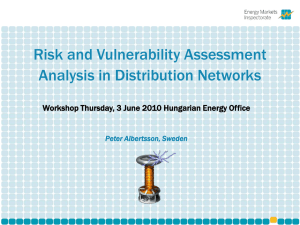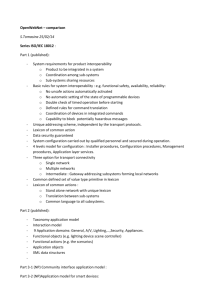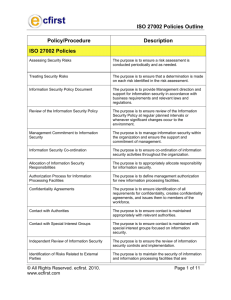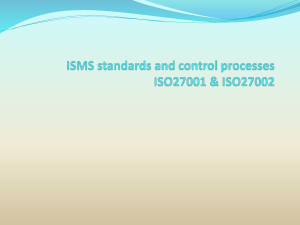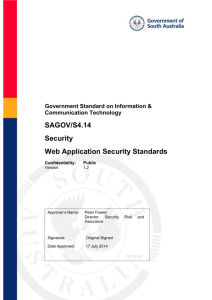Information Security Management Policy
advertisement
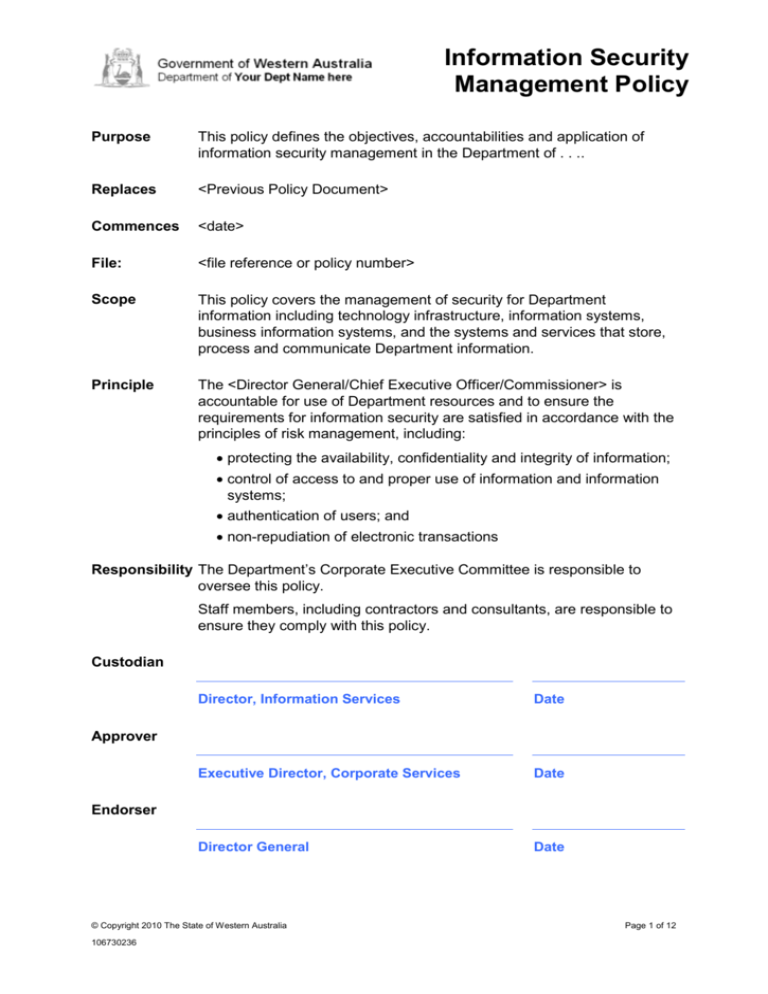
Information Security Management Policy Purpose This policy defines the objectives, accountabilities and application of information security management in the Department of . . .. Replaces <Previous Policy Document> Commences <date> File: <file reference or policy number> Scope This policy covers the management of security for Department information including technology infrastructure, information systems, business information systems, and the systems and services that store, process and communicate Department information. Principle The <Director General/Chief Executive Officer/Commissioner> is accountable for use of Department resources and to ensure the requirements for information security are satisfied in accordance with the principles of risk management, including: protecting the availability, confidentiality and integrity of information; control of access to and proper use of information and information systems; authentication of users; and non-repudiation of electronic transactions Responsibility The Department’s Corporate Executive Committee is responsible to oversee this policy. Staff members, including contractors and consultants, are responsible to ensure they comply with this policy. Custodian Director, Information Services Date Executive Director, Corporate Services Date Director General Date Approver Endorser © Copyright 2010 The State of Western Australia 106730236 Page 1 of 12 Department of . . . 1. Information Security Management Policy Policy The Department of . . . is responsible for the security of its information and information systems. 2. Objectives To ensure that Department requirements for information security are satisfied in accordance with the principles of risk management: a. the control of access to and proper use of information and information systems b. the availability, confidentiality and integrity of information c. the authentication of users d. the non-repudiation of electronic transactions 3. Definition Interpretation:‘Department information’ means e. any official information, government record or personal information (see the Criminal Code, the State Records Act 2000 (WA), Freedom of Information Act 1992) f. which is created or obtained by the Department, stored by the Department or on Department facilities Interpretation:‘Department resources’ includes g. official information, equipment and facilities (see the Public Sector Management Act (1994), section 9(b)) 4. Application a. The Department will adopt relevant standards for information security management and risk management, including WA Government guidelines b. The compliance with these guidelines is to be managed by the Information Security Group c. Compliance means: regular reviews of security exposures investigation of security infringements, as required an ongoing action plan to achieve continuous improvement in security, within the operational budget allocation d. The Department’s framework for information security management is summarised in the appendices. <Departments should include, policy lists, and delegations> 5. Accountabilities and Responsibilities 5.1. The Director General a. Is accountable for Department compliance with this information security management policy © Copyright 2010 The State of Western Australia 106730236 Page 2 of 12 Department of . . . Information Security Management Policy b. Shall establish a management group to approve information security policies, standards and procedures, and to supervise the management of the information security management process. 5.2. Director, Information Services Director, Information Services is responsible for: a. Information b. Information infrastructure c. Information policies 5.3. Information Security Group The Information Security Group is responsible for: a. formulating and managing the Department’s information security policy b. Coordinating the implementation of security across the Department. 5.4. Information Security Manager The Information Security Manager, <Section>, is responsible for: a. establishing and maintaining a management system for the information security process within the Department b. maintaining the Department’s information and security policies, such as the Computer and Telecommunications Facility Policy. 5.5. Staff Department staff are responsible to: c. understand and comply with the Department’s information security policies, standards and procedures, such as: the Computer and Telecommunications Facilities Policy the Intellectual Property Policy the Backup and Recovery Policy the Virus and Vulnerability Patching Policy d. never subvert or attempt to subvert any security measures related to the protection of Department information systems and assets e. report immediately any actual or suspected security incidents, weaknesses or failures to the Service Desk, Line Manager or Information Security Manager 5.6. System Owners a. Are responsible for ensuring the compliance of their systems with this Information Security Management Policy. 5.7. Divisional Heads, Executive Directors, Directors a. Are responsible for managing the risks to their business processes and assets b. Must manage the information and information systems that belong to their business processes and assets © Copyright 2010 The State of Western Australia 106730236 Page 3 of 12 Department of . . . Information Security Management Policy c. Must ensure that the security requirements that are justified for their processes and assets are satisfied d. Are responsible for managing the risks to their information and information systems e. Are responsible for authorising, controlling access to and administering their information and systems f. Must identify and justify security requirements for their information and information systems g. Are responsible for the development, management and maintenance of jurisdiction specific information security management system including policy, standards and procedures h. Are responsible for their staff and contractors being properly educated about relevant Department information security policy, standards and procedures and being properly trained and authorised to use the information and information systems necessary to perform their work. 6. Policy Promulgation Commencement date Communication process 7. Policy Review The Department reviews and updates this policy as needed. 8. Contact Questions related to this policy document may be directed to the Director, Information Services on (08) 9999-9999. © Copyright 2010 The State of Western Australia 106730236 Page 4 of 12 Department of . . . Appendix – 17799:2006) 9. Information Security Management Policy Minimum Standards (per ISO AS/NZS ISO/IEC Information security is the protection of information from a wide range of threats in order to ensure business continuity, minimize business risk, and maximize return on investments and business opportunities. Information security is achieved by implementing a suitable set of controls, including policies, processes, procedures, organizational structures and software and hardware functions. 9.1. How to establish security requirements It is essential that an organization identifies its security requirements. There are three main sources of security requirements. 1. One source is derived from assessing risks to the organization, taking into account the organization’s overall business strategy and objectives. Through a risk assessment, threats to assets are identified, vulnerability to and likelihood of occurrence is evaluated and potential impact is estimated. 2. Another source is the legal, statutory, regulatory, and contractual requirements that an organization, its trading partners, contractors, and service providers have to satisfy, and their socio-cultural environment. 3. A further source is the particular set of principles, objectives and business requirements for information processing that an organization has developed to support its operations. 9.2. Assessing Security Risks Security requirements are identified by a methodical assessment of security risks. Expenditure on controls needs to be balanced against the business harm likely to result from security failures. 9.3. Selecting Controls Once security requirements and risks have been identified and decisions for the treatment of risks have been made, appropriate controls should be selected and implemented to ensure risks are reduced to an acceptable level [for the Department]. 9.4. Minimum Controls [Protections or Objectives] Controls considered to be essential to an organization from a legislative point of view include, depending on applicable legislation[, must address]: a) data protection and privacy of personal information (see 15.1.4); b) protection of organizational records (see 15.1.3); c) intellectual property rights (see 15.1.2). 9.5. [Recommended] Common Controls Controls considered to be common practice for information security include: a) information security policy document (see 5.1.1); b) allocation of information security responsibilities (see 6.1.3); © Copyright 2010 The State of Western Australia 106730236 Page 5 of 12 Department of . . . Information Security Management Policy c) information security awareness, education, and training (see 8.2.2); d) correct processing in applications (see 12.2); e) technical vulnerability management (see 12.6); f) business continuity management (see 14); g) management of information security incidents and improvements (see 13.2). 10. Appendix – Information Security Categories (delete as needed) The International standards define the following information security categories: Category Summary Risk assessment Security policy management direction Organization of information security governance of information security Asset management inventory and information assets Human resources security security aspects for employees joining, moving and leaving an organization Physical and environmental security protection of the computer facilities Communications and operations management management of technical security controls in systems and networks Access control restriction of access rights to networks, systems, applications, functions and data classification of Information systems acquisition, development building security into applications and maintenance Information security incident management anticipating and responding appropriately to information security breaches Business continuity management protecting, maintaining and recovering business- critical processes and systems Compliance ensuring conformance with information security policies, standards, laws and regulations AS/NZS ISO/IEC 17799:2006 is identical with and has been reproduced from ISO/IEC 17799:2005. ISO/IEC 27002:2005 comprises ISO/IEC 17799:2005 and ISO/IEC 17799:2005/Cor.1:2007. Its technical content is identical to that of ISO/IEC 17799:2005. ISO/IEC 17799:2005/Cor.1:2007 changes the reference number of the standard from 17799 to 27002. © Copyright 2010 The State of Western Australia 106730236 Page 6 of 12 Information Security Management Policy 11. Appendix – Information Security Controls (delete as needed) AS/NZS ISO/IEC 17799:2006 defines 39 information security controls in twelve categories. Category 4 Risk Assessment Section 4.1 Assessing Security risks 4.2 Treating Security risks 5 Security Policy 5.1 Information Security Policy 6 Organization Of Information Security 6.1 Internal Organization 6.2 External Parties 7 Asset Management 7.1 Responsibility For Assets To maintain the security of the organization’s information and information processing facilities that are accessed, processed, communicated to, or managed by external parties. To achieve and maintain appropriate protection of organizational assets. 7.2 Information Classification To ensure that information receives an appropriate level of protection. © Copyright 2010 The State of Western Australia 106730236 Purpose Risk assessments should identify, quantify, and prioritize risks against criteria relevant to the organization. Controls to manage or reduce the risk or its impact To provide management direction and support for information security in accordance with business requirements and relevant laws and regulations. To manage information security within the organization. Sub-sections 6.1.1 Management Commitment To Information Security 6.1.2 Information Security Co-Ordination 6.1.3 Allocation Of Information Security Responsibilities 6.1.4 Authorization Process For Information Processing Facilities 6.1.5 Confidentiality Agreements 6.1.6 Contact With Authorities 6.1.7 Contact With Special Interest Groups 6.1.8 Independent Review Of Information Security 6.2.1 Identification Of Risks Related To External Parties 6.2.2 Addressing Security When Dealing With Customers 6.2.3 Addressing Security In Third Party Agreements 7.1.1 Inventory Of Assets 7.1.2 Ownership Of Assets 7.1.3 Acceptable Use Of Assets 7.2.1 Classification Guidelines 7.2.2 Information Labelling And Handling Page 7 of 12 Department of . . . Category 8 Human Resources Security Information Security Management Policy Section 8.1 Prior To Employment 8.2 During Employment 8.3 Termination Or Change Of Employment 9 Physical And Environmental Security 9.1 Secure Areas 9.2 Equipment Security © Copyright 2010 The State of Western Australia 106730236 Purpose To ensure that employees, contractors and third party users understand their responsibilities, and are suitable for the roles they are considered for, and to reduce the risk of theft, fraud or misuse of facilities. To ensure that employees, contractors and third party users are aware of information security threats and concerns, their responsibilities and liabilities, and are equipped to support organizational security policy in the course of their normal work, and to reduce the risk of human error To ensure that employees, contractors and third party users exit an organization or change employment in an orderly manner. To prevent unauthorized physical access, damage, and interference to the organization’s premises and information. To prevent loss, damage, theft or compromise of assets and interruption to the organization’s activities. Sub-sections 8.2.1 Management Responsibilities 8.2.2 Information Security Awareness, Education, And Training 8.2.3 Disciplinary Process 8.3.1 Termination Responsibilities 8.3.2 Return Of Assets 8.3.3 Removal Of Access Rights 9.1.1 Physical Security Perimeter 9.1.2 Physical Entry Controls 9.1.3 Securing Offices, Rooms, And Facilities 9.1.4 Protecting Against External And Environmental Threats 9.1.5 Working In Secure Areas 9.1.6 Public Access, Delivery, And Loading Areas 9.2.1 Equipment Siting And Protection 9.2.2 Supporting Utilities 9.2.3 Cabling Security 9.2.4 Equipment Maintenance 9.2.5 Security Of Equipment Off-Premises 9.2.6 Secure Disposal Or Re-Use Of Equipment 9.2.7 Removal Of Property Page 8 of 12 Department of . . . Category 10 Communications And Operations Management Information Security Management Policy Section 10.1 Operational Procedures And Responsibilities Purpose To ensure the correct and secure operation of information processing facilities. 10.2 Third Party Service Delivery Management To implement and maintain the appropriate level of information security and service delivery in line with third party service delivery agreements. To minimize the risk of systems failures. To protect the integrity of software and information. To maintain the integrity and availability of information and information processing facilities. To ensure the protection of information in networks and the protection of the supporting infrastructure To prevent unauthorized disclosure, modification, removal or destruction of assets, and interruption to business activities. To maintain the security of information and software exchanged within an organization and with any external entity. To ensure the security of electronic commerce services, and their secure use. 10.3 System Planning And Acceptance 10.4 Protection Against Malicious And Mobile Code 10.5 Back-Up 10.6 Network Security Management 10.7 Media Handling 10.8 Exchange Of Information 10.9 Electronic Commerce Services © Copyright 2010 The State of Western Australia 106730236 Sub-sections 10.1.1 Documented Operating Procedures 10.1.2 Change Management 10.1.3 Segregation Of Duties 10.1.4 Separation Of Development, Test, And Operational Facilities 10.2.1 Service Delivery 10.2.2 Monitoring And Review Of Third Party Services 10.2.3 Managing Changes To Third Party Services 10.3.1 Capacity Management 10.3.2 System Acceptance 10.4.1 Controls Against Malicious Code 10.4.2 Controls Against Mobile Code 10.5.1 Information Back-Up 10.6.1 Network Controls 10.6.2 Security Of Network Services 10.7.1 Management Of Removable Media 10.7.2 Disposal Of Media 10.7.3 Information Handling Procedures 10.7.4 Security Of System Documentation 10.9.1 Electronic Commerce 10.9.2 On-Line Transactions 10.9.3 Publicly Available Information Page 9 of 12 Department of . . . Information Security Management Policy Category Section 10.10 Monitoring Purpose To detect unauthorized information processing activities. 11 Access Control 11.1 Business Requirement For Access Control 11.2 User Access Management To control access to information. 11.3 User Responsibilities 11.4 Network Access Control To prevent unauthorized user access, and compromise or theft of information and information processing facilities. To prevent unauthorized access to networked services. 11.5 Operating System Access Control To prevent unauthorized access to operating systems. 11.6 Application And Information Access Control To prevent unauthorized access to information held in application systems. To ensure information security when using mobile computing and teleworking facilities. 11.7 Mobile Computing And Teleworking © Copyright 2010 The State of Western Australia 106730236 Sub-sections 10.10.1 Audit Logging 10.10.2 Monitoring System Use 10.10.3 Protection Of Log Information 10.10.4 Administrator And Operator Logs 10.10.5 Fault Logging 10.10.6 Clock Synchronization 11.1.1 Access Control Policy To ensure authorized user access and to prevent unauthorized access to information systems. 11.2.1 User Registration 11.2.2 Privilege Management 11.2.3 User Password Management 11.2.4 Review Of User Access Rights 11.3.1 Password Use 11.3.2 Unattended User Equipment 11.3.3 Clear Desk And Clear Screen Policy 11.4.1 Policy On Use Of Network Services 11.4.2 User Authentication For External Connections 11.4.3 Equipment Identification In Networks 11.4.4 Remote Diagnostic And Configuration Port Protection 11.4.5 Segregation In Networks 11.4.6 Network Connection Control 11.4.7 Network Routing Control 11.5.1 Secure Log-On Procedures 11.5.2 User Identification And Authentication 11.5.3 Password Management System 11.5.4 Use Of System Utilities 11.5.5 Session Time-Out 11.5.6 Limitation Of Connection Time 11.6.1 Information Access Restriction 11.6.2 Sensitive System Isolation 11.7.1 Mobile Computing And Communications 11.7.2 Teleworking Page 10 of 12 Department of . . . Category 12 Information Systems Acquisition, Development and Maintenance Information Security Management Policy Section 12.1 Security Requirements Of Information Systems Purpose To ensure that security is an integral part of information systems. Sub-sections 12.1.1 Security Requirements Analysis And Specification 12.2 Correct Processing In Applications To prevent errors, loss, unauthorized modification or misuse of information in applications. 12.3 Cryptographic Controls To protect the confidentiality, authenticity or integrity of information by cryptographic means. To ensure the security of system files. 12.2.1 Input Data Validation 12.2.2 Control Of Internal Processing 12.2.3 Message Integrity 12.2.4 Output Data Validation 12.3.1 Policy On The Use Of Cryptographic Controls 12.3.2 Key Management 12.4 Security Of System Files 12.5 Security In Development And Support Processes 12.6 Technical Vulnerability Management 13 Information Security Incident Management 13.1 Reporting Information Security Events And Weaknesses 13.2 Management Of Information Security Incidents And Improvements © Copyright 2010 The State of Western Australia 106730236 To maintain the security of application system software and information. To reduce risks resulting from exploitation of published technical vulnerabilities. To ensure information security events and weaknesses associated with information systems are communicated in a manner allowing timely corrective action to be taken. To ensure a consistent and effective approach is applied to the management of information security incidents. 12.5.1 Change Control Procedures 12.5.2 Technical Review Of Applications After Operating System Changes 12.5.3 Restrictions On Changes To Software Packages 12.5.4 Information Leakage 12.5.5 Outsourced Software Development 12.6.1 Control Of Technical Vulnerabilities 13.1.1 Reporting Information Security Events 13.1.2 Reporting Security Weaknesses 13.2.1 Responsibilities And Procedures 13.2.2 Learning From Information Security Incidents 13.2.3 Collection Of Evidence Page 11 of 12 Department of . . . Information Security Management Policy Category 14 Business Continuity Management Section 14.1 Information Security Aspects Of Business Continuity Management Purpose To counteract interruptions to business activities and to protect critical business processes from the effects of major failures of information systems or disasters and to ensure their timely resumption. 15 Compliance 15.1 Compliance With Legal Requirements To avoid breaches of any law, statutory, regulatory or contractual obligations, and of any security requirements. 15.2 Compliance With Security Policies And Standards, And Technical Compliance 15.3 Information Systems Audit Considerations To ensure compliance of systems with organizational security policies and standards. To maximize the effectiveness of and to minimize interference to/from the information systems audit process. Sub-sections 14.1.1 Including Information Security In The Business Continuity Management Process 14.1.2 Business Continuity And Risk Assessment 14.1.3 Developing And Implementing Continuity Plans Including Information Security 14.1.4 Business Continuity Planning Framework 14.1.5 Testing, Maintaining And Re-Assessing Business Continuity Plans 15.1.1 Identification Of Applicable Legislation 15.1.2 Intellectual Property Rights (Ipr) 15.1.3 Protection Of Organizational Records 15.1.4 Data Protection And Privacy Of Personal Information 15.1.5 Prevention Of Misuse Of Information Processing Facilities 15.1.6 Regulation Of Cryptographic Controls 15.2.1 Compliance With Security Policies And Standards 15.2.2 Technical Compliance Checking 15.3.1 Information Systems Audit Controls 12. Potential Policies (delete as needed) The ISO/AS/NZS Information Security Controls can be used as a framework or structure for information security policies. © Copyright 2010 The State of Western Australia 106730236 Page 12 of 12

